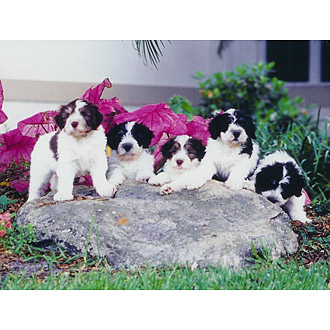

|
Premier Pons-Natasha's first litter
|
Evaluating PON Puppies
|
As a result of being in the breed for some eleven years and having
international contacts, I have been fortunate in learning a lot about PONS.
A number of international breeders have confided that a "puppy test" is
often misleading because they are normally conducted only one time and one
observation of certain characteristics does not necessarily prove a true
test of individual puppies. For example, let us assume a litter of 6 at 6 weeks of age is being evaluated. Puppies are alert and playing, and the tester picks one and removes it from the others to the secluded testing spot, hopefully some place where the puppy has never been taken previously. The tester runs it through the tests, takes 15 or 20 minutes, returns puppy to his littermates and picks another one. By the time the, 4th, 5th or 6th puppy is chosen, they may well be tired or even irritated. The later ones may not be equally evaluated if they nap time is approaching and many may not react to a stimulus they would have reacted to, if they were chosen earlier on in the testing. Consequently, the most accurate evaluation of a litter will be obtained by a caring breeder who cares for the puppies every day. She can document, who is the first at the door, who jumps on the others the most, who is the first to the food and who is the last, who is the first to come running when they are called, who makes eye contact and who doesn't, who submits easily to human touch, who handles a strange environment without being nervous, etc. It is far more accurate to base puppy evaluations on the above observations over several weeks, than one test. Basically, if I were considering a puppy for agility, I would pay attention to the parents and inquire if they were ever active in agility training. There are many variables in puppy testing and many are difficult to control. Litter dynamics play a significant role in puppy evaluation. If prospective PON puppy buyers are considering a breeder in a far away state, why not ask for a video and determine temperament from observations while watching the litter in action. Some common faults to avoid when choosing a PON puppy: * Very narrow jaw and small head size. The correct ratio between the mouth and skull is1:1. * Cow hocks -may possibly indicate future hip issues * Bad bite - may be confirmed by a vet * Legs which are too long or short (an experienced breeder can evaluate this) Correct proportions should be height 9 and length 10 * The puppy should be rectangular rather than square in appearance * Character - avoid shy or nervous puppies |
|
The 7 Stages of Puppy Development
|
|
"Dogs need to sniff the ground; it's how they keep abreast of current events. The ground is a giant dog newspaper, containing all kinds of late-breaking dog news items, which, if they are especially urgent,are often continued in the next yard." -Dave Barry |
ponbreeders/polishculture/faq/multipon/allergymanagement/naturalfleaprevention/evalponpups/ponpolitics